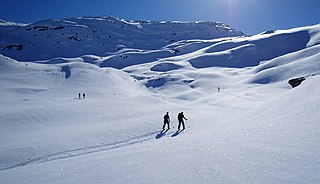
Cross-country skiing is a form of skiing whereby skiers traverse snow-covered terrain without use of ski lifts or other assistance. Cross-country skiing is widely practiced as a sport and recreational activity; however, some still use it as a means of travel. Variants of cross-country skiing are adapted to a range of terrain which spans unimproved, sometimes mountainous terrain to groomed courses that are specifically designed for the sport.
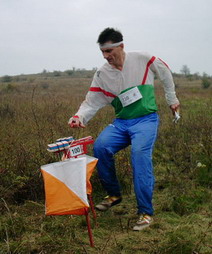
Orienteering is a group of sports that involve using a map and compass to navigate from point to point in diverse and usually unfamiliar terrain whilst moving at speed. Participants are given a topographical map, usually a specially prepared orienteering map, which they use to find control points. Originally a training exercise in land navigation for military officers, orienteering has developed many variations. Among these, the oldest and the most popular is foot orienteering. For the purposes of this article, foot orienteering serves as a point of departure for discussion of all other variations, but almost any sport that involves racing against a clock and requires navigation with a map is a type of orienteering.

Winter sports or winter activities are competitive sports or non-competitive recreational activities which are played on snow or ice. Most are variations of skiing, ice skating and sledding. Traditionally, such games were only played in cold areas during winter, but artificial snow and artificial ice allow more flexibility. Playing areas and fields consist of either snow or ice.

The 1992 Winter Olympics, officially known as the XVI Olympic Winter Games and commonly known as Albertville '92, were a winter multi-sport event held from 8 to 23 February 1992 in and around Albertville, France. Albertville won the bid to host the Winter Olympics in 1986, beating Sofia, Falun, Lillehammer, Cortina d'Ampezzo, Anchorage, and Berchtesgaden. The 1992 Winter Olympics were the last winter games held in the same year as the Summer Olympics. The Games were the fifth Olympic Games held in France and the country's third Winter Olympics, after the 1924 Winter Games in Chamonix and the 1968 Winter Games in Grenoble. This games was the first of two consecutive Olympic games to be held in Western Europe, preceding the 1992 Summer Olympics in Barcelona, Spain.

Ski cross is a skiing competition which incorporates terrain features traditionally found in freestyle skiing with courses which include big-air jumps and high-banked turns. In spite of the fact that it is a timed racing event, it is often considered a type of freestyle skiing. What sets ski cross apart from other alpine skiing disciplines is that it involves more than one skier racing down the course. Any intentional contact with other competitors like grabbing or any other forms of contact meant to give the competitor an advantage leads to disqualification.
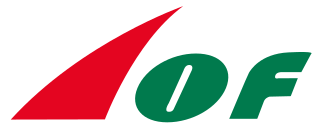
The International Orienteering Federation (IOF) is the international governing body of the sport of orienteering. The IOF head office is located in Karlstad, Sweden. The IOF governs four orienteering disciplines: foot orienteering, mountain bike orienteering, ski orienteering, and trail orienteering.
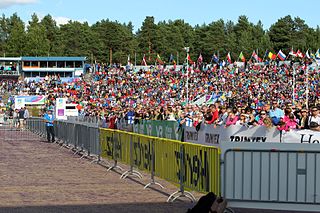
The World Orienteering Championships is an international orienteering competition which has been organized by the International Orienteering Federation (IOF) since 1966. The World Orienteering Championships is considered to be the most prestigious competition in competitive orienteering. The races are contested between members of the IOF, which are each aligned to a National Olympic Committee.
Hilde Gjermundshaug Pedersen is a Norwegian cross-country skier. Her first Olympic medal was a silver 4 × 5 km relay at the 2002 Winter Olympics in Salt Lake City. At the 2006 Winter Olympics in Turin, she took the bronze medal in the 10 km classical interval start event. Pedersen is the oldest woman ever to win a cross country skiing World Cup race, which she did at age 41 in January 2006 in Otepää, Estonia.
Håvard Tveite was a Norwegian orienteering competitor. He was Relay World Champion from 1987 and 1989, and has a silver medal from 1991 and a bronze medal from 1997. He also obtained bronze in the individual course at the 1989 World Orienteering Championships.
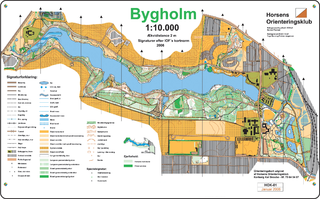
An orienteering map is a map specially prepared for use in orienteering events. It is a large-scale topographic map with extra markings to help the participant navigate through the course.

The World Cup in Ski Orienteering is a series of ski-orienteering competitions organized by the International Orienteering Federation. The first official World Cup was held in 1989, then every second year up to 1999, and then in 2000, 2001, 2003, 2006, and 2007–2008.

Eduard Alexandrovich Khrennikov is a Russian ski-orienteering competitor and world champion, and three times winner of the overall World cup. He received a gold medal in the long course at the 2004, 2005 and 2007 World Ski Orienteering Championships, in the middle distance in 2002 and 2007, and in sprint in 2004 and 2007. He won the overall World Cup in Ski Orienteering in 2000, 2003 and 2006, and finished 3rd in 2001. Khrennikov by winning the middle distance at the 2017 Winter Military World Games in Sochi, Russia won his fifth medal in this competition. He continued winning three more gold medals there.

Martin Johansson is a Swedish orienteering, ski-orienteering, and cross-country skiing competitor, a medallist at the orienteering world championships, and a 2004 Junior World Champion in relay. He received bronze medals in sprint at the World Orienteering Championships in Kyiv 2007 and Olomouc 2008. His brother, Lars, is a member of the Rockford Icehogs

A control point is a marked waypoint used in orienteering and related sports such as rogaining and adventure racing. It is located in the competition area; marked both on an orienteering map and in the terrain, and described on a control description sheet. The control point must be identifiable on the map and on the ground. A control point has three components: a high visibility item, known as a flag or kite; an identifier, known as a control code; and a recording mechanism for contestants to record proof that they visited the control point. The control point is usually temporary, except on a permanent orienteering course.

Mountain bike orienteering is an orienteering endurance racing sport on a mountain bike where navigation is done along trails and tracks. Compared with foot orienteering, competitors usually are not permitted to leave the trail and track network. Navigation tactics are similar to ski-orienteering, where the major focus is route choice while navigating. The main difference compared to ski-orienteering is that navigation is done at a higher pace, because the bike can reach higher speeds. As the biker reaches higher speeds, map reading becomes more challenging.

Foot orienteering is the oldest formal orienteering sport, and the one with the most "starts" per year. Usually, a FootO is a timed race in which participants start at staggered intervals, are individually timed, and are expected to perform all navigation on their own. The control points are shown on the orienteering map and must be visited in the specified order. Standings are determined first by successful completion of the course, then by shortest time on course.
The 2014 Winter Olympics and Paralympics venues are divided between two "clusters" located in and around Sochi, Russia.
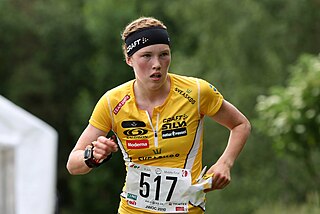
Tove Alexandersson is a Swedish foot orienteer, ski orienteer, skyrunner, trail runner, ski mountaineer and skysnow runner. Alexandersson has won gold medals at world championships in five different sports plus a silver medal in a sixth sport, and has won a total of 21 gold medals at the World Orienteering Championships, making her the second most successful orienteer in history by number of gold medals at World Championships, behind Simone Niggli-Luder. Alexandersson holds the record for the number of gold medals in a row at the World Orienteering Championships, winning 11 in a row between 2018 and 2022.

The International Ski Mountaineering Federation (ISMF) is the international governing body responsible for Ski mountaineering competitions. Its main aims are promotion, regulation, and development of Ski mountaineering worldwide. In 2026 the sport will be part of the programme of the Olympic Winter Games Milano Cortina 2026.

Competitive cross-country skiing encompasses a variety of race formats and course lengths. Rules of cross-country skiing are sanctioned by the International Ski Federation and by various national organizations. International competitions include the FIS Nordic World Ski Championships, the FIS Cross-Country World Cup, and at the Winter Olympic Games. Such races occur over homologated, groomed courses designed to support classic (in-track) and freestyle events, where the skiers may employ skate skiing. It also encompasses cross-country ski marathon events, sanctioned by the Worldloppet Ski Federation, and cross-country ski orienteering events, sanctioned by the International Orienteering Federation. Related forms of competition are biathlon, where competitors race on cross-country skis and stop to shoot at targets with rifles, and paralympic cross-country skiing that allows athletes with disabilities to compete at cross-country skiing with adaptive equipment.



















